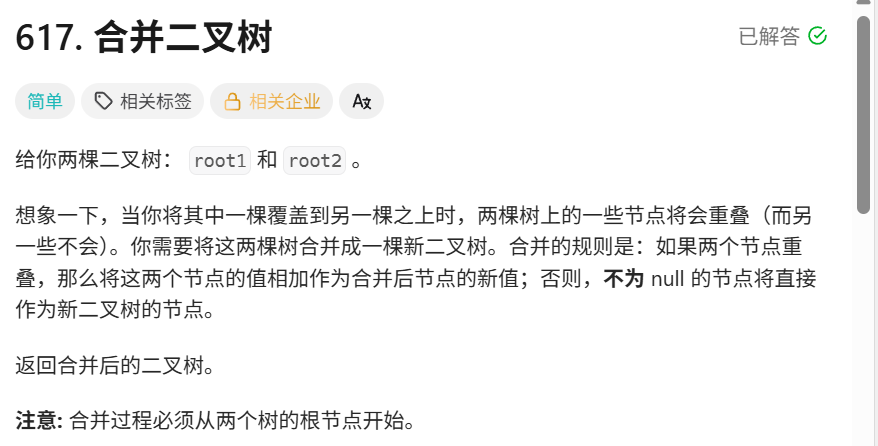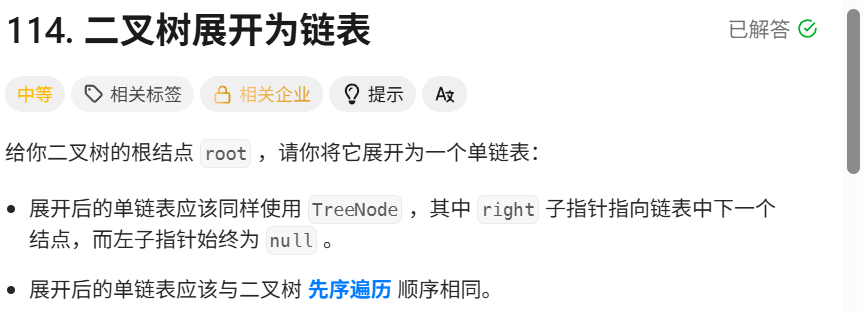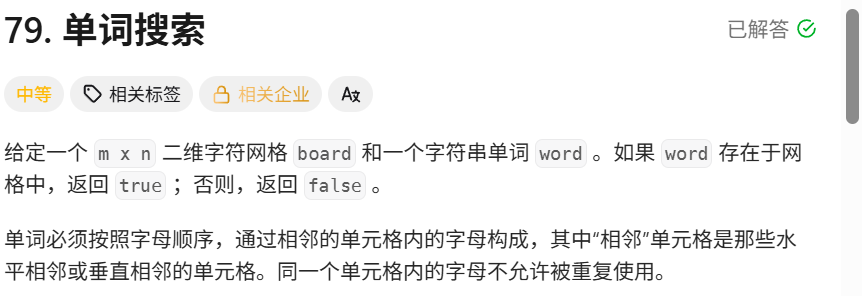
python
# Definition for a binary tree node.
# class TreeNode:
# def __init__(self, val=0, left=None, right=None):
# self.val = val
# self.left = left
# self.right = right
class Solution:
def buildTree(self, preorder: List[int], inorder: List[int]) -> Optional[TreeNode]:
def recur(root, left, right):
if left > right: return
node = TreeNode(preorder[root])
i = dic[preorder[root]]
node.left = recur(root+1, left, i-1)
node.right = recur(i-left+root+1, i+1, right)
return node
dic = {}
for i in range(len(inorder)):
dic[inorder[i]] = i
return recur(0, 0, len(inorder) - 1)这里用前序确定根节点位置,用中序确定left和right
-
前序遍历(preorder):根节点 → 左子树 → 右子树(第一个元素是根节点)
-
中序遍历(inorder):左子树 → 根节点 → 右子树(根节点左侧是左子树,右侧是右子树)
通过前序遍历确定根节点,然后在中序遍历中找到该根节点的位置,从而划分左右子树的范围,递归构建整棵树

python
# Definition for a binary tree node.
# class TreeNode:
# def __init__(self, val=0, left=None, right=None):
# self.val = val
# self.left = left
# self.right = right
class Solution:
def mergeTrees(self, root1: Optional[TreeNode], root2: Optional[TreeNode]) -> Optional[TreeNode]:
if not root1: return root2
if not root2: return root1
return TreeNode(root1.val+root2.val, self.mergeTrees(root1.left, root2.left), self.mergeTrees(root1.right, root2.right))
python
# Definition for a binary tree node.
# class TreeNode:
# def __init__(self, val=0, left=None, right=None):
# self.val = val
# self.left = left
# self.right = right
class Solution:
def flatten(self, root: Optional[TreeNode]) -> None:
"""
Do not return anything, modify root in-place instead.
"""
if not root: return None
left_tail = self.flatten(root.left)
right_tail = self.flatten(root.right)
if left_tail:
left_tail.right = root.right
root.right = root.left
root.left = None
return right_tail or left_tail or root分别找到左右子树的末尾节点,然后连接左右节点并都放到右节点上

python
class Solution:
def leastInterval(self, tasks: List[str], n: int) -> int:
cnt = Counter(tasks)
nbucket = cnt.most_common(1)[0][1]
last_bucket_size = list(cnt.values()).count(nbucket)
res = (nbucket - 1) * (n + 1) + last_bucket_size
return max(res, len(tasks))
设计桶大小为n+1,相同的任务不能放在同一个桶里面,然后对于重复的任务,我们只能将每个都放入不同的桶中,因此桶的个数就是重复次数最多的任务的个数。一个桶不管是否放满,其占用的时间均为 n+1,这是因为后面桶里的任务需要等待冷却时间。最后一个桶是个特例,由于其后没有其他任务需等待,所以占用的时间为桶中的任务个数。所以
总排队时间 = (桶个数 - 1) * (n + 1) + 最后一桶的任务数
last_bucket_size = list(ct.values()).count(nbucket)
计算有多少个任务和最高频任务一样频繁,就是最后一个桶肯定放的都是最高频任务,那么就是最后一个桶的任务数了。

python
class Solution:
def exist(self, board: List[List[str]], word: str) -> bool:
m, n = len(board), len(board[0])
def dfs(i, j, k):
if not 0 <= i < m or not 0 <= j < n or board[i][j] != word[k]: return False
if k == len(word) - 1: return True
board[i][j] = ''
res = dfs(i-1, j, k+1) or dfs(i+1, j, k+1) or dfs(i, j+1, k+1) or dfs(i, j-1, k+1)
board[i][j] = word[k]
return res
for i, row in enumerate(board):
for j, e in enumerate(row):
if dfs(i, j, 0): return True
return False判断,置空,递归,恢复,返回